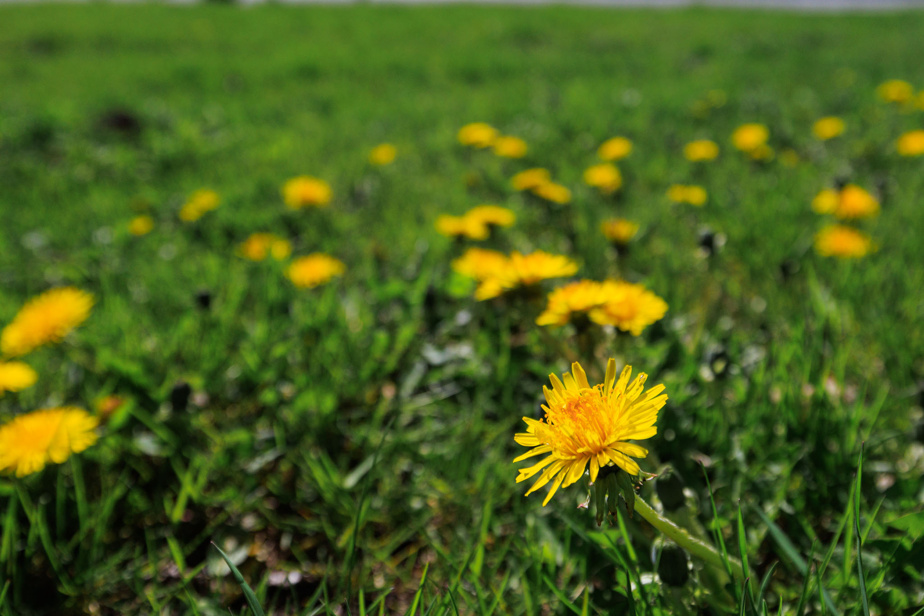First, what is the Dandelion Challenge?
It is a Quebec initiative inspired by the British No Mow May movement, which was launched in 2021 by Miel & CO beekeepers to promote the health of pollinators and improve biodiversity. This means delaying mowing your lawn in spring to, as explained on the Challenge website, allow “pollinators to stock up on pollen and nectar from dandelions and other flowers”.
So should we store our mower for the entire month of May?
Not necessarily. Even if this is what the No Mow May movement advocates, the Dandelion Challenge does not impose a duration, in particular because the flowering period of dandelions varies depending on the region of Quebec. Once they have gone to seed (the famous little silk parachutes), they are no longer useful to pollinators. So we can cut them.
Can I really save bees by keeping dandelions on my land?
“Save” is a big word. Pierre Giovenazzo, professor at Laval University and bee specialist, recalls that the greatest threats to pollinators are urban sprawl, deforestation and pesticides. However, offering them a source of food at the end of winter can certainly help them develop, he maintains. In spring, bees feed heavily on tree flowers, but some species only offer them pollen, unlike dandelions, which also contain nectar.

PHOTO JOSIE DESMARAIS, LA PRESSE ARCHIVES
A bee collects nectar from a dandelion.
“Nectar is fuel for bees,” explains Pierre Giovenazzo. It is a source of carbohydrates that domestic bees need greatly to develop their colony. […] And there are so many dandelions that the bees don’t have to spend a lot of energy [pour s’alimenter]. He adds that although dandelion pollen is not high in protein, bees have other sources to turn to this time of year.
In addition to domestic bees, other pollinators also benefit from the presence of dandelions, including native wild bees, which are abundant in the city, and bumblebees.
In an article published on the magazine’s website Turf & Reca botanist from the World Wide Fund for Nature (WWF) says the No Mow May movement is not necessarily useful in North America…
We contacted Ryan Godfrey and his comments are a little more nuanced than what this magazine reports, which says it “serves the Canadian lawn and grounds care industry.” “In Ontario and Quebec, if you let your lawn grow, you are more likely to see introduced species like dandelions, clovers and other non-native plants that don’t provide as much nutritional value and habitat for wildlife and pollinators,” explains the man who works for WWF-Canada. He compares dandelion to a bag of chips. But if chips give us enough energy to go to the grocery store, at least that’s it, right?
“I’m not saying that No Mow May has no value,” he explains. It’s a step in the right direction, but there’s a lot more people can do. »
Guillaume Grégoire, specialist in improving horticultural practices in urban areas and professor at Laval University, believes that the awareness that this type of campaign brings should not be neglected. An opinion shared by biologist Claude Lavoie, author of Dandelion vs. Lawn – A Story of Love, Hate, and Lawnmowers. “Among those who let the dandelions grow in May, there are some who will take extra steps. We have to take people where they are,” he said in an interview with The Presslast month.
Read the article “To finish with the perfect lawn”
So what are the best ways to help pollinators at the citizen level?
“There are several trees which have flowerings which are not necessarily spectacular, but which are very useful to pollinators,” notes Guillaume Grégoire. I am thinking, among others, of the sugar maple and fruit trees such as apple trees, crabapple trees, etc. » Among the other actions that can be implemented: reduce the frequency of mowing all summer, create flower beds on your land, leave certain plots fallow, stop using fertilizers and pesticides and plant a variety of native plants and flowers like wild thyme, agastache, aster and milkweed, which will help pollinators with specific needs like the monarch butterfly.

PHOTO HUGO-SÉBASTIEN AUBERT, LA PRESSE ARCHIVES
Bee foraging on agastache plants
The diversity of species that will frequent your land could then surprise you. In a study whose results are to be published, Guillaume Grégoire and his research team identified 17 genera and 72 species of bees as well as 12 genera and 16 species of hoverflies on plots of lawn that had been diversified. “We found a greater diversity of pollinators than we expected. »
Learn more
-
- 155
- Number of cities in Quebec that participated in the Dandelion Challenge in 2023
Source: Dandelion Challenge
